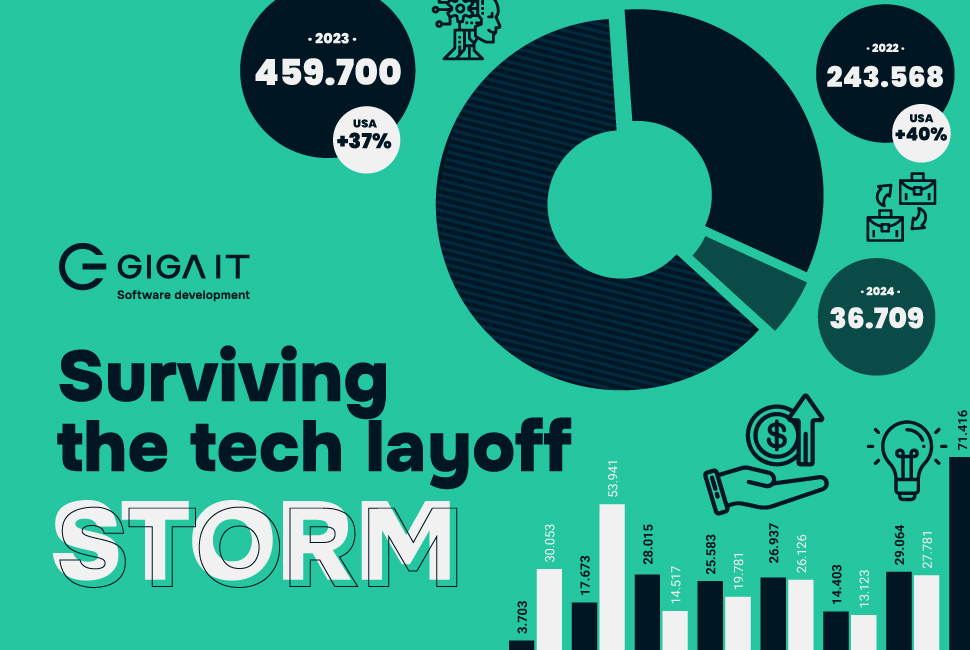This report delves into the intricacies of layoffs within the technology sphere, shedding light on how these workforce adjustments are reshaping the global employment landscape, with a particular emphasis on the situation unfolding in the United States.
The world of technology, a vibrant yet challenging place
The rapid expansion witnessed in the technology sector during the pandemic’s peak has been met with a sobering reality check. The fallout from geopolitical tensions and economic downturns has necessitated a recalibration of hiring strategies, leading many tech companies to pivot from recruitment drives to the painful process of layoffs. While the sector continues to be a beacon of job creation on a global scale, the relentless march of Artificial Intelligence, shifting consumer behaviors, and the aftershocks of macroeconomic and geopolitical crises have underscored the need for adaptation and resilience.
Layoff globally and in the U.S.A.
In recent years, the tech industry has witnessed an unprecedented wave of layoffs, impacting companies of all sizes and sectors. This phenomenon, which began to take shape in 2022, has intensified in 2023 and 2024, coinciding with a global economic landscape characterized by inflation, rising interest rates, and slowing growth.

The United States, the epicenter of technological innovation, has not been immune to this trend. Tech giants like Netflix, Twitter, Meta, Tesla, and Microsoft have announced workforce reductions, laying off thousands of employees across various departments. While these measures are painful for the affected workers, they are seen by the companies as necessary to adjust their operations to the new economic reality.
Some of the drivers factors driving layoffs
Slowing growth: After years of rapid growth, the technology industry is beginning to show signs of slowing down. This has led companies to reevaluate their staffing needs and cut costs, including payroll.
Shifting priorities: Companies are refocusing their investments towards areas of higher growth, such as artificial intelligence and cloud computing. This has led to layoffs in areas that are no longer considered strategic.
Inflation and rising interest rates: The current economic climate, characterized by inflation and rising interest rates, has made it more expensive for companies to finance their operations. This has led some companies to reduce costs, including payroll.
Meanwhile, what was happening at GIGA IT?
Amidst this period of uncertainty and flux, one entity stands out as a testament to resilience: Giga IT. Despite the prevailing challenges, Giga IT has bucked the trend, defying market pressures to chart a course of expansion. Over the past two years alone, Giga IT has bolstered its ranks with a remarkable 47% increase in its workforce, emerging as a beacon of stability in an otherwise turbulent sea of layoffs and retrenchments.
As the tech industry navigates these choppy waters, the story of Giga IT serves as both a source of inspiration and a case study in adaptability. Yet, amidst the tales of resilience, questions linger about the broader implications of these layoffs on the industry’s trajectory and the livelihoods of countless individuals whose careers hang in the balance. In the pages that follow, we delve deeper into the nuances of this paradigm shift, exploring the ramifications for workers, businesses, and the very fabric of the tech ecosystem.
“At GIGA, our culture is built on fostering trusting relationships, flexibility, and adaptability. We are passionate about what we do and committed to our work. We promote a collaborative team environment where incredible ideas flourish. We operate under agile methodologies and rely on data, but without losing sight of what’s most important for businesses: the people.” Ailén Simon
Expansion and how we continue to add talent to our team
In the fast-paced realm of technology, expansion and talent acquisition are the lifeblood of a company’s sustained success. To navigate this ever-evolving landscape, we, as a tech-savvy HR team, must implement robust strategies that attract and retain the top minds in the field. Here are two fundamental pillars to achieve this goal:
Define a compelling and clear vision:
Articulating a clear and compelling vision that resonates with potential candidates is paramount. This vision should effectively communicate the goals, values, and culture of our tech team, highlighting the opportunities for professional growth, intellectual challenges, and the positive impact they will have on our company.
Implement a strategic recruitment process:
A well-defined recruitment process is crucial to identify and attract the most suitable candidates. This entails establishing clear role profiles, leveraging effective recruitment channels, conducting structured interviews, and evaluating both technical and soft skills.
Expanding and acquiring talent in a technology team requires comprehensive strategies that address both attracting and retaining the best professionals. By defining a clear vision, implementing a strategic recruitment process, offering a competitive compensation and benefits package, and promoting a positive work environment, we can position ourselves as an attractive employer and build high-performance technology teams.
Would you like to join an innovative team? Be part of our professional database.
The Future of tech employment: lessons learned and a look ahead
The tech industry, once a seemingly invincible force of job creation, has entered a period of adaptation. While layoffs dominate headlines, success stories like Giga IT offer valuable lessons. The relentless march of technology, coupled with economic realities, necessitates a focus on agility and resilience. Businesses must adapt their strategies, and workers must embrace continuous learning.
Giga IT’s story serves as a beacon of hope, demonstrating that growth is still possible amidst challenging times. By fostering a culture that attracts and retains top talent, Giga IT has positioned itself for continued success.






0 Comments